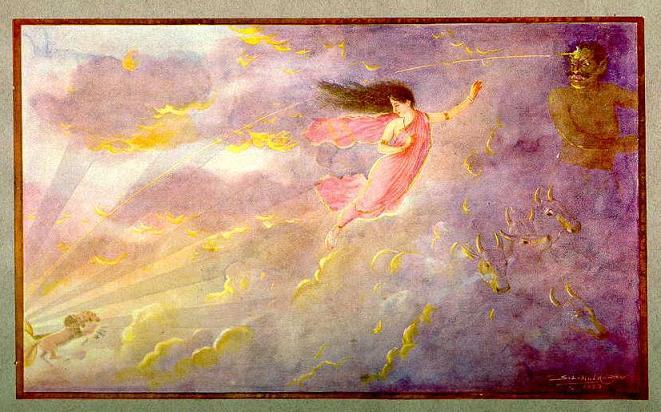srigurubhyO namahA |
The idea of pratyAhAra or sense withdrawal is conveyed in this the 133rd mantrA of the thirumandiram. Using the metaphor of the tortoise which escapes danger through withdrawal, the sage highlights the necessity of sense control to achieve a steady mind that can accept conflicting experiences without losing calm.
பெருமை சிறுமை அறிந்தெம் பிரான்போல்
அருமை எளிமை அறிந்தறி வார்ஆர்
ஒருமையுள் ஆமைபோல் உள்ஐந்து அடக்கி
இருமையுங் கேட்டிருந் தார்புரை அற்றே. I.1.21.133.
The idea of pratyAhAra or sense withdrawal is conveyed in this the 133rd mantrA of the thirumandiram. Using the metaphor of the tortoise which escapes danger through withdrawal, the sage highlights the necessity of sense control to achieve a steady mind that can accept conflicting experiences without losing calm.
பெருமை சிறுமை அறிந்தெம் பிரான்போல்
அருமை எளிமை அறிந்தறி வார்ஆர்
ஒருமையுள் ஆமைபோல் உள்ஐந்து அடக்கி
இருமையுங் கேட்டிருந் தார்புரை அற்றே. I.1.21.133.
Who there be who, like
our Lord, distinct know
The great and the small, the difficult and the facile?
They, unto tortoise, drawing in senses five under the shell,
They heard and saw This and Next, all impurities dispelled. I.1.21.133.
The great and the small, the difficult and the facile?
They, unto tortoise, drawing in senses five under the shell,
They heard and saw This and Next, all impurities dispelled. I.1.21.133.
Com - who, like our Lord,
distinct know The great and the small, Like our Lord siva, who pervades
everything and is present within the atom as well as the mighty universe, the
difficult and the facile? Who there be, and thus knows the immense greatness
and the incredible minuteness (of the great and the small) alongside each
other, who else is there in this world who could experience and ‘know’ (these
conflicting experiences) thus with equanimity? They, unto tortoise, drawing in
senses five under the shell, Those sAdhakAs (those practising the path shown by
the sage) who with a steady mind practise the withdrawal of the sense
instruments by arresting the outward flow of the five senses and turning it
inward, like the tortoise, They heard and saw This and Next, all impurities
dispelled. Will reach the state where they will be able to see the greatness
and the smallness and experience them faultlessly (i.e. without the taint of
duality or contrary experiences).
# Here the sage is
instructing the reader in the necessity of the yOga practise known as
pratyAhArA or sense withdrawal for the purpose of attaining a calm and steady
disposition. It would be well to understand here that the siddhars are in
complete agreement with the tantric and vEdic concept that one must be
sufficiently disengaged with one’s idea of ‘doership’ and the idea that one is
the ‘experiencer’. Hence chitta shuddi or internal purification is an important
first step to building a steady ground for realisation to take root. ChittA is
an aggregate term – when the manas (mind), buddhi (intellect) and ahamkArA
(ego/identity principle) are spoken of together the word chittA is used to
describe it. It is in this realm that the idea of ‘I am doer’ and ‘I am
experiencer’ is present. It is here that ‘me’ and ‘mine’ originate. When there
is not enough clarity in these faculties, then the idea that ‘I am a limited
jIvA, caught in the transmigratory cycle of life and death and powerless in the
hands of fate’ takes root firmly. This clouds judgement regarding this
phenomenal world of name and form and one thus gets firmly bound by delusions
and performs wrong actions and suffers unhappiness.
pratyAhArA or sense
withdrawal is the method through which the usually outward flow of the sense instruments
(ears, skin, eyes, tongue and nose) is checked and then by practise reversed.
This would enable the mind to understand and experience without bias. To act
without motive.
The sage uses the
example of the tortoise, which when confronted by danger, reacts to protect
itself by withdrawing its limbs and head (4+1) into the hard shell. Similarly,
he indicates here that the sAdhakA or adept must practise the method of
withdrawing the five senses inward to protect himself from the danger of the
external world. After the first two lines of the verse which describe the
equanimity with which siva engages with this world, the second two lines are
pointing the reader in the direction in which even he might find the means to
reach such an equanimity of perception. Through sense withdrawal, the adept
will be able to gradually reach a place where he will be able to view the great
and the small without conflict. To put it in other words, the idea here is to
reconcile the opposing forces to achieve the steady state. This is the ancient
alchemical concept which is symbolised by the Chemical Wedding.

